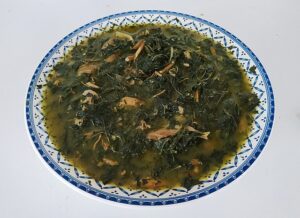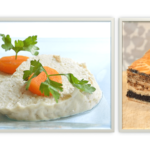When people think about Jewish Food names, they often come up with those that are derived from Hebrew, Yiddish, or Ladino, or those that are clearly tied to Shabbat, holidays and other Jewish celebrations. And yet, there is another category of Jewish Food names that many overlook, but which are the most obvious, since they display their Jewishness as openly as the European ghettos were closed. I’m referring to the foods that other cultures identify as Jewish!
One of the fascinating things I’ve noticed as I’ve continued researching Jewish Foods from around the world is how frequently I encounter foods whose very names identify them as being a part of our people’s cuisine. In different parts of the world, in different languages, we encounter foods that even non-Jews call “Jewish-” whatever.
Often people get into heated discussions about what makes a food Jewish, or (ridiculously, in my opinion) if such a thing even exists. Many place outlandish demands on Jewish gastronomy — demands of uniqueness and indigeneity — that they do not require as precursors for associating a dish with any other people. Beyond responding to such arguments, however, I’d say that if even non-Jews claim a dish is Jewish, then we can safely assume that it probably is!
A Few Examples

From the late medieval and early modern times, a classic fish dish among Ashkenazi Jewry was carpe a la juive. Typically served cold in its own aspic, one finds numerous accounts by non-Jews who ate this dish and became passionate devotees.(3)Joan Nathan Quiches, Kugels, and Couscous; Edouard de Pomiane The Jews of Poland: Recollections and Recipes A similar cold fish that is found throughout Spanish and Latin communities is called truchas a la judia, made using trout instead of carp.(4)John Cooper Eat and Be Satisfied Encountering such similar foods in two such vastly different cuisines also underscores the migrations of Jews and the interconnectedness of our disparate communities.
Italy: Queen of Jewish Food Names

But when one explores Italian cuisine, one encounters numerous dishes identified as Jewish, using different ways of saying the same thing. Perhaps the most famous is the Roman dish carciofi alla giudia, Jewish style fried artichokes (featured in the picture at the top of this post). Polpette alla giudia are Jewish style meatballs; caponata ebraica — the Hebrew version of the classic Sicilian eggplant casserole; and triglie alla Mosaica is a different triglie preparation involving tomatoes, and identified as Jewish via its connection to Moses. What made these foods Jewish connected them to kashrut (the meatballs were likely considered Jewish since they were made with beef instead of pork) or our early adoption of some ingredients as those who disseminated them throughout Italy (eggplants, tomatoes, artichokes).
One of the more intriguing and entertaining examples is Rebecchine di Gerusalemme. This interesting dish uses two pieces of chilled polenta to sandwich an anchovy paste, then breading and frying them. Most references identify these unique sandwiches as Jewish, but the origins of the name remain obscure. However, as Joyce Goldstein wrote in Cucina Ebraica, one of the first English-language cookbooks to explore Italian Jewish cuisine, “I doubt that these fritters were ever served in Jerusalem. Instead, the name Gerusalemme seems to be the Italian way to let you know that the dish originated in the Jewish community, just as the name Rebecca, or in this case the diminutive Rebecchine, indicates a Jewish origin.”
Less Noticed Jewish Food Names

We also often forget — in light of current tensions — how integrated Jews were in the Muslim world for so many centuries. The old Arabic saying “Sleep in a Christian bed and enjoy Jewish food” clearly hints at the Muslim appreciation of Jewish cuisine.(6)S.D. Goitein A Mediterranean Society, Vol. IV: Daily Life Indeed, within the foods of the greater North African and Middle Eastern regions, we also encounter foods identified as Jewish. One of the most beloved Egyptian dishes is a thick soup called mulukhiyya, made using a mucilaginous type of leafy green. In medieval times, the green was commonly referred to as baqla yahudiyya, “Jewish vegetable,” and is commonly known in English as Jew’s mallow.(7)David Friedenreich, “Food and Drink – Medieval Period” Encyclopedia of Jews in the Islamic World (Not to be confused with common mallow, which I wrote about here.)
Digging through medieval Arabic-language cookbooks, we also encounter dishes identified as Jewish. The so-called Anonymous Andalusian Cookbook contains six dishes explicitly identified as Jewish, such as “Jewish Partridge,” “A Stuffed, Buried Jewish Dish,” and “A Jewish Dish of Eggplants Stuffed with Meat.” These come from the Western Muslim world around the Iberian peninsula and North Africa. But the most intriguing (and confusing) recipe comes from the Eastern Muslim region, in a 14th-century Egyptian cookbook called Kitab al-wasf al-at’ima al-mu’tada, “The Description of Familiar Foods.” The dish is referred to as “Meatballs Cursed by the Jews.” Maddeningly, no explanation is given as to why the Jews may have cursed this dish, but lest you think it may not actually have been associated with us, a later copy of this cookbook from the 17th or 18th century changes its name to simply “Meatballs of the Jews.”(8)Helene Jawhara Piner Sephardi: Cooking the History
Whatever the reasons in each place, foods from all over the world have been identified by the local populations as connected with their Jewish sub-populations. Jews have spread everywhere, but our distinctive eating habits means that while we adopt and adapt local dishes and flavors, we maintain certain differences in our specific gastronomic choices that differentiate our menus.
Found Something Cool Here? Show Me Some Love and Share the Post!
Footnotes
| ↑1 | Claudia Roden The Book of Jewish Food |
|---|---|
| ↑2 | Gil Marks Encyclopedia of Jewish Food |
| ↑3 | Joan Nathan Quiches, Kugels, and Couscous; Edouard de Pomiane The Jews of Poland: Recollections and Recipes |
| ↑4 | John Cooper Eat and Be Satisfied |
| ↑5 | Edda Servi Machlin The Classic Cuisine of the Italian Jews I |
| ↑6 | S.D. Goitein A Mediterranean Society, Vol. IV: Daily Life |
| ↑7 | David Friedenreich, “Food and Drink – Medieval Period” Encyclopedia of Jews in the Islamic World |
| ↑8 | Helene Jawhara Piner Sephardi: Cooking the History |






Michael Lewyn
I often find that you can still get Jew’s Mallow (also known as molokhia) in Arabic food stores. To my knowledge it is the only hechshered product made in Egypt.